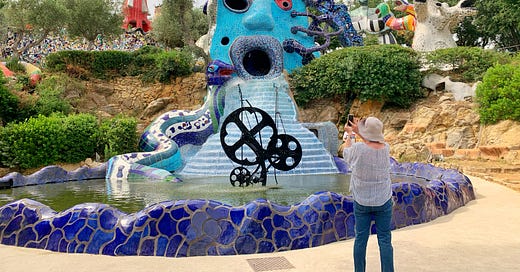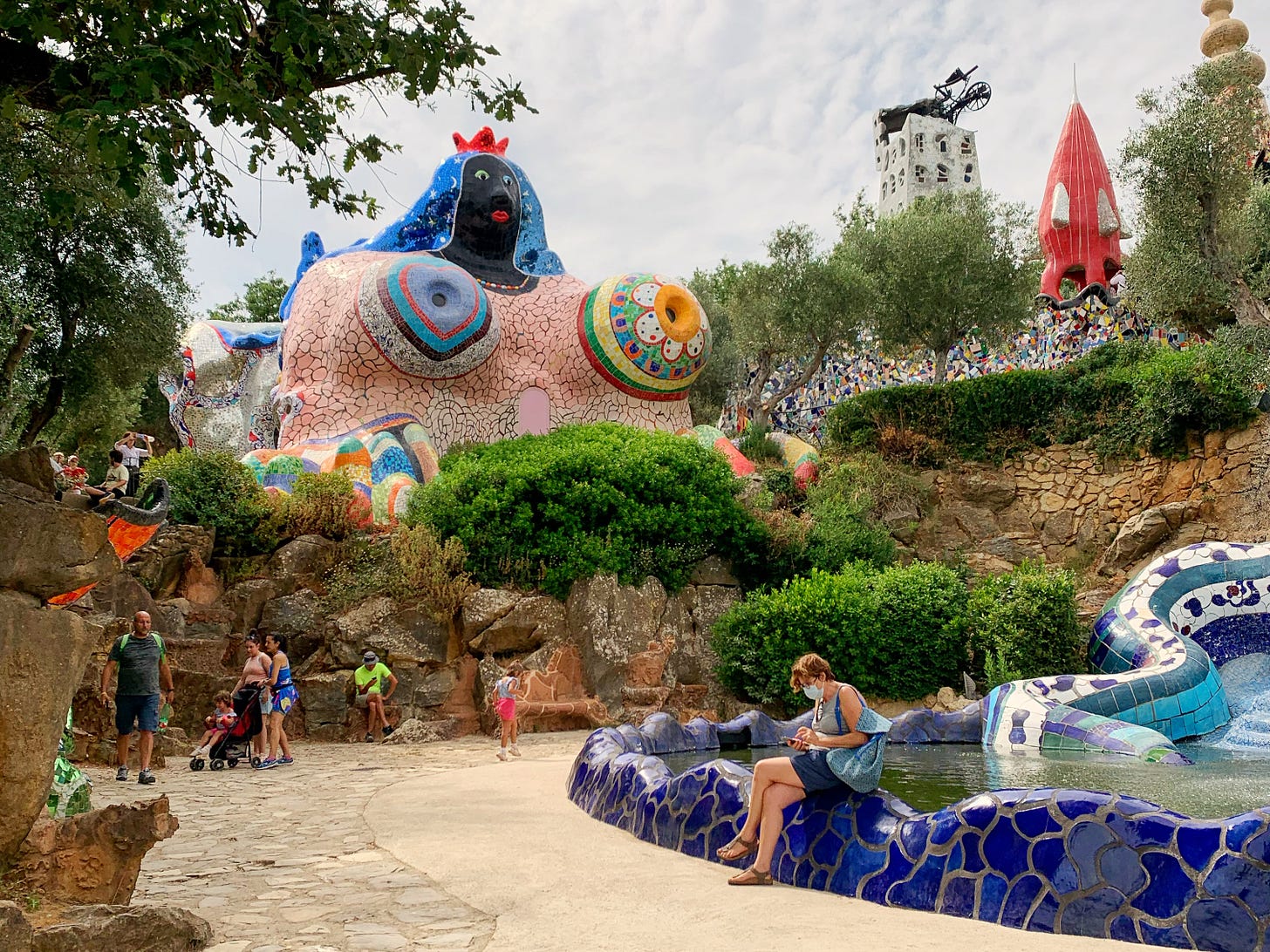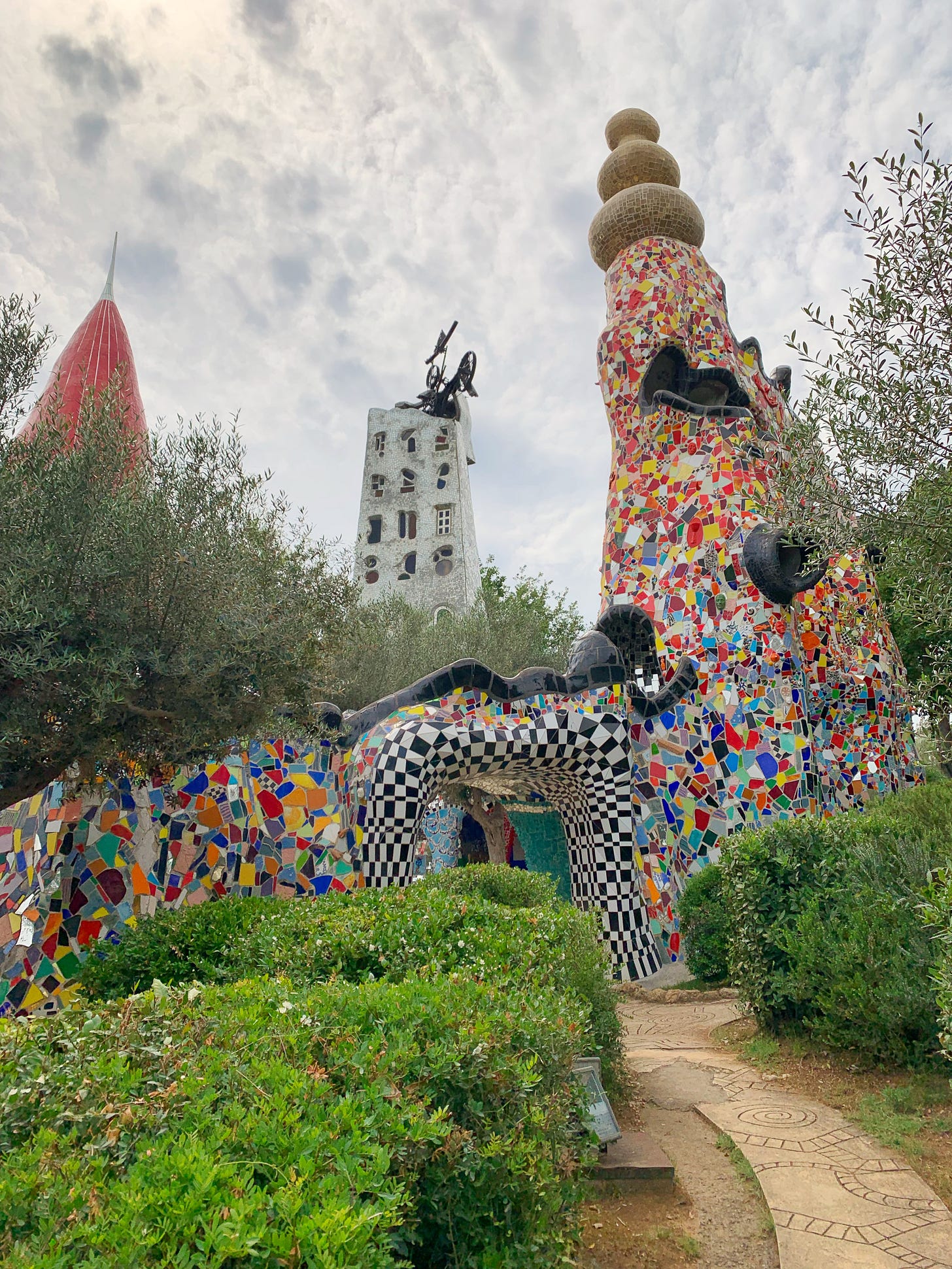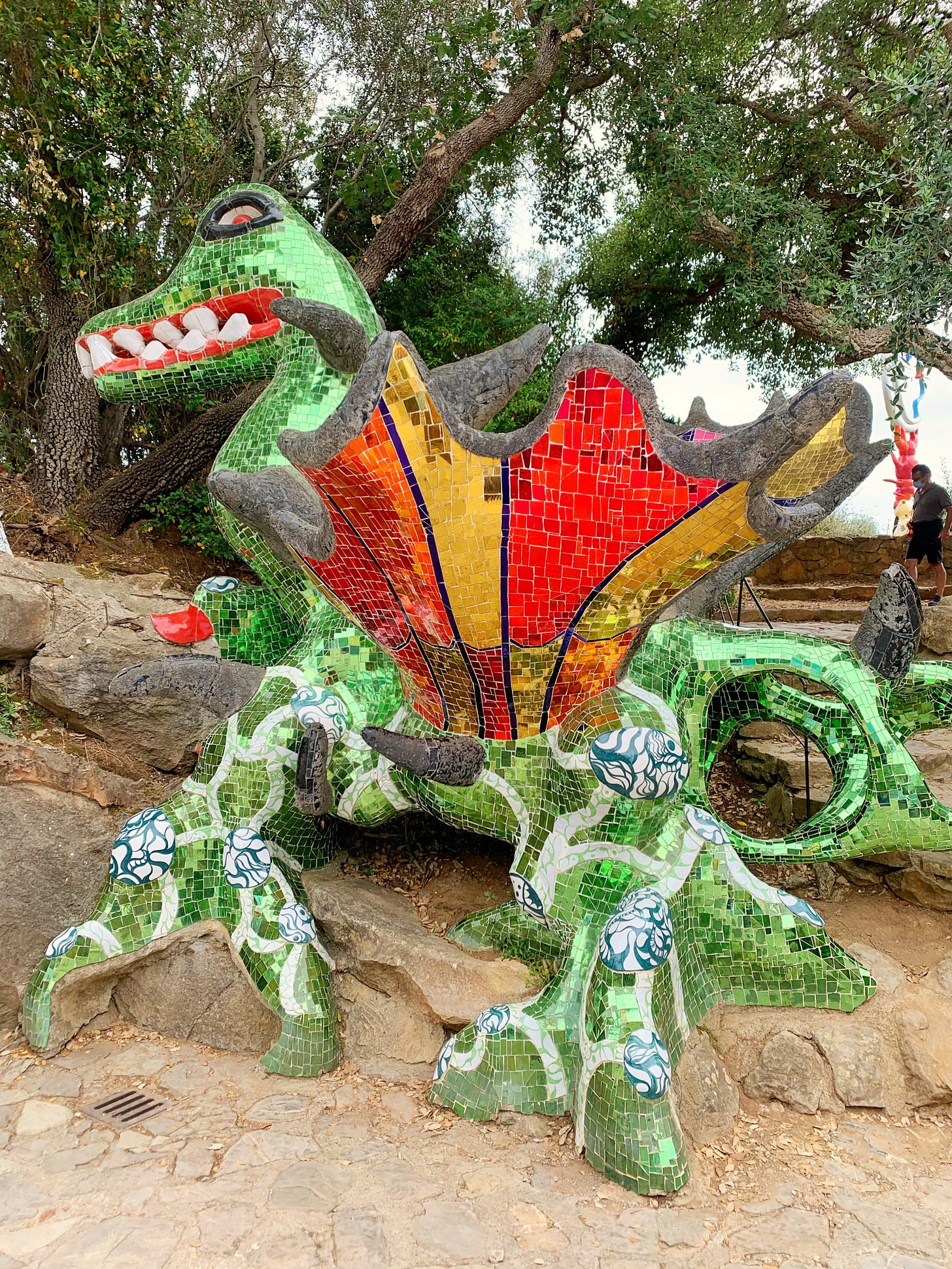The Giardino dei Tarocchi (Tarot Garden) in Tuscany Should Be on Every Art Lover’s Radar
Issue #38
Located in the Maremma, slightly closer to Rome than to Florence, the little town of Capalbio is far from Tuscany’s big hitters, but it’s a pilgrimage spot for art lovers. That’s because a large estate just outside the center of town is home to the Giardino dei Tarocchi (the Tarot Garden), a sculpture garden full of larger-than-life figures representing the major arcana of the tarot cards and the crowning achievement of French-American artist Niki de Saint Phalle.
I don’t remember how I first heard about the Giardino dei Tarocchi, but I visited it with Marco a couple of years ago and it has remained in my memory as one of the greatest art installations I’ve ever seen in my life. I included it in a recent article about lesser-known Italian summer holidays, but I think it deserves a more in depth feature.
Even if you don’t know much about the tarot deck, it doesn’t really matter. I don’t know much about tarot, but I was blown away by the sheer scale, ambition, and artistry of the garden. Marco and I simply strolled through it, gawking at the enormous figures with their bulbous breasts, climbing up and inside the structures—including a little house covered inside and out in mirror mosaics, where Saint Phalle lived during the garden’s construction—and reading the inscriptions on the sidewalks.
There’s a devil and a dragon, a sphinx, male and female figures, the tower of Babel, and something that looks like a rocket ship, just to name a few. The majority of the sculptures are covered in colorful mosaics inspired by the ones at Antoni Gaudí’s Park Güell in Barcelona. Saint Phalle was also inspired by the Parco dei Mostri, a 16th-century mannerist sculpture garden built by Prince Vicino Orsini in Tuscia, the region in between Rome and Tuscany. As the New Yorker wrote, “It is as if a psychedelic bomb had exploded in the most picturesque part of Tuscany.”
You might be wondering how a French-American artist ended up creating a massive sculpture garden in rural Tuscany. Without getting into her entire life story, Saint Phalle was born into an aristocratic French family in 1930 but moved to the United States with her parents (her mother was American) when she was three years old.
At 18, she married the writer Harry Mathews, but soon rebelled against domestic life. After an affair with an English lord and a suicide attempt, she was taken to a psychiatric clinic in Nice, where she underwent electroshock therapy. It was there that she began to make art, which she credits with bringing back her sanity.
When she got out, she and Mathews moved with their two children to Paris, where they led a rather bohemian life. Saint Phalle took a studio in Montparnasse in an artistic community where she met Brancusi and Jean Tinguely, an avant-garde Swiss artist whom she would eventually marry.
She left Mathews in 1960 and abandoned their children in order to pursue the life of an artist. She became known for her shooting paintings, a kind of proto-performance art form in which she would use a rifle to shoot paint at a canvas assembled with a sort of collage of domestic items, such as baby doll arms, scissors, eggbeaters, and knives.
She began making Nanas—a sort of feminist fertility goddess—in 1964. The dancing female figures with massive hips and breasts became her signature, and you can see several of them in the Tarot Garden. She and Tinguely collaborated on many projects together, including sculptural installations in Central Park, Jerusalem, and Fontainebleau, outside of Paris.
She was quite well established by 1977, when Maria Agnelli—the famous model, wife of the president of Fiat, and a member of the aristocratic Caracciolo family—convinced her brothers to give Saint Phalle a plot of 14 acres in Tuscany on which to build her Tarot Garden. The idea had apparently come to her in a dream. She’s been quoted as saying that she wanted to create “a sort of joyland, where you could have a new kind of life that would just be free.”
Saint Phalle devoted more than two decades of her life to the garden’s creation and funded it with $5 million of her own money, which she raised in part by selling her Nanas as inflatable pool toys, much to the shock of the art world. She also created a perfume, the proceeds of which funded a third of the garden. She and Tinguely, by then her husband and collaborator, designed and created the garden together, managing a team of artisans—including the local postman—to help with the monumental work. It officially opened in 1998, but Saint Phalle was planning to add a maze to it when she died in 2002.
I didn’t know most of this when I visited the garden, though I was somewhat familiar with Saint Phalle’s work. I first encountered it while studying in Paris, where the colorful, kinetic Stravinskij Fountain that she and Tinguely created stands near the Centre Pompidou. Learning the story behind the Tarot Garden and Saint Phalle’s life has given me a new appreciation for it.
And I’m not the only one. Zoe Stella Shapiro, the founder and CEO of Stellavision Travel, as well as a fellow art aficionado, is taking a group of travelers to visit the Tarot Garden this summer as part of the Rome Relax Remix tour.
“Whether you are passionate about the esoteric, modern art or the history of mosaics in Italy, these life-size (up to building size!) sculptures are ready to enhance what you thought you knew about Tuscany and Italy's tarot traditions. For me it's all three,” Shapiro says, adding that the tarot deck was invented right here in Italy.
Carved into the sidewalk of the garden is this, “If life is a game of cards, we are born without knowing the rules yet we must play our hand. Throughout the ages, poets, philosophers, alchemists, artists have devoted themselves to discovering their meaning.”
Perhaps, if you decide to take a detour to the Tarot Garden, you might just find the meaning of life. Even if you don’t, though, I can all but guarantee you’ll find some joy and inspiration.
Further Reading
The New Yorker article I referenced earlier was my main source of information about the Tarot Garden and Saint Phalle’s fascinating life.
Travel + Leisure also covered the Tarot Garden in the March 2023 issue.
I included it in this roundup of lesser-known Italian summer holidays for Noted by Quintessentially.
To learn more about the Parco dei Mostri in Bomarzo, one of Saint Phalle’s inspirations, check out my article about Tuscia for Hemispheres.
To learn more about Stellavision, check out my interview with Zoe Stella Shapiro and see the full itinerary for the Rome Relax Remix tour here. There are still some spots available.












